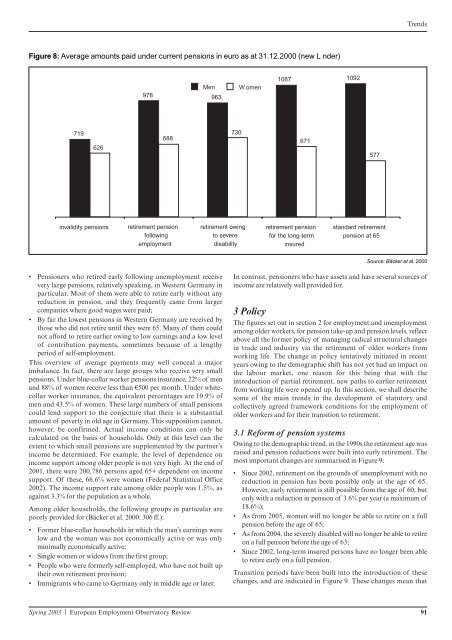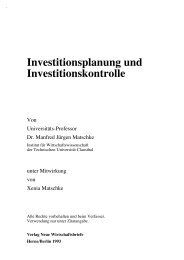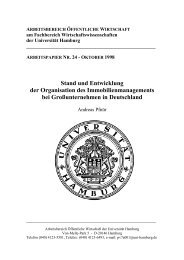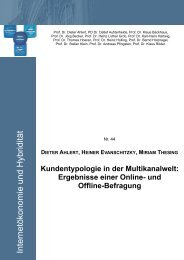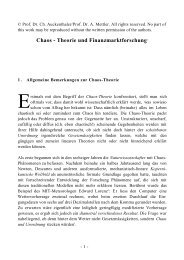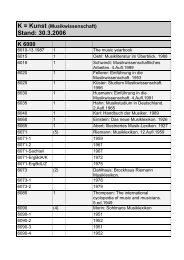FRANCE The
FRANCE The
FRANCE The
Create successful ePaper yourself
Turn your PDF publications into a flip-book with our unique Google optimized e-Paper software.
Figure 8: Average amounts paid under current pensions in euro as at 31.12.2000 (new L nder)<br />
719<br />
626<br />
invalidity pensions<br />
978 963<br />
688<br />
retirement pension<br />
following<br />
employment<br />
• Pensioners who retired early following unemployment receive<br />
very large pensions, relatively speaking, in Western Germany in<br />
particular. Most of them were able to retire early without any<br />
reduction in pension, and they frequently came from larger<br />
companies where good wages were paid;<br />
• By far the lowest pensions in Western Germany are received by<br />
those who did not retire until they were 65. Many of them could<br />
not afford to retire earlier owing to low earnings and a low level<br />
of contribution payments, sometimes because of a lengthy<br />
period of self-employment.<br />
This overview of average payments may well conceal a major<br />
imbalance. In fact, there are large groups who receive very small<br />
pensions. Under blue-collar worker pensions insurance, 22% of men<br />
and 88% of women receive less than €500 per month. Under whitecollar<br />
worker insurance, the equivalent percentages are 10.9% of<br />
men and 43.5% of women. <strong>The</strong>se large numbers of small pensions<br />
could lend support to the conjecture that there is a substantial<br />
amount of poverty in old age in Germany. This supposition cannot,<br />
however, be confirmed. Actual income conditions can only be<br />
calculated on the basis of households. Only at this level can the<br />
extent to which small pensions are supplemented by the partner’s<br />
income be determined. For example, the level of dependence on<br />
income support among older people is not very high. At the end of<br />
2001, there were 200,786 persons aged 65+ dependent on income<br />
support. Of these, 66.6% were women (Federal Statistical Office<br />
2002). <strong>The</strong> income support rate among older people was 1.5%, as<br />
against 3.3% for the population as a whole.<br />
Among older households, the following groups in particular are<br />
poorly provided for (Bäcker et al. 2000: 306 ff.):<br />
• Former blue-collar households in which the man’s earnings were<br />
low and the woman was not economically active or was only<br />
minimally economically active;<br />
• Single women or widows from the first group;<br />
• People who were formerly self-employed, who have not built up<br />
their own retirement provision;<br />
• Immigrants who came to Germany only in middle age or later.<br />
Men W omen<br />
Spring 2003 | European Employment Observatory Review 91<br />
730<br />
retirement owing<br />
to severe<br />
disability<br />
1087<br />
671<br />
retirement pension<br />
for the long-term<br />
insured<br />
1092<br />
577<br />
standard retirement<br />
pension at 65<br />
Trends<br />
Source: Bäcker et al. 2000<br />
In contrast, pensioners who have assets and have several sources of<br />
income are relatively well provided for.<br />
3 Policy<br />
<strong>The</strong> figures set out in section 2 for employment and unemployment<br />
among older workers, for pension take-up and pension levels, reflect<br />
above all the former policy of managing radical structural changes<br />
in trade and industry via the retirement of older workers from<br />
working life. <strong>The</strong> change in policy tentatively initiated in recent<br />
years owing to the demographic shift has not yet had an impact on<br />
the labour market, one reason for this being that with the<br />
introduction of partial retirement, new paths to earlier retirement<br />
from working life were opened up. In this section, we shall describe<br />
some of the main trends in the development of statutory and<br />
collectively agreed framework conditions for the employment of<br />
older workers and for their transition to retirement.<br />
3.1 Reform of pension systems<br />
Owing to the demographic trend, in the 1990s the retirement age was<br />
raised and pension reductions were built into early retirement. <strong>The</strong><br />
most important changes are summarised in Figure 9:<br />
• Since 2002, retirement on the grounds of unemployment with no<br />
reduction in pension has been possible only at the age of 65.<br />
However, early retirement is still possible from the age of 60, but<br />
only with a reduction in pension of 3.6% per year (a maximum of<br />
18.6%);<br />
• As from 2005, women will no longer be able to retire on a full<br />
pension before the age of 65;<br />
• As from 2004, the severely disabled will no longer be able to retire<br />
on a full pension before the age of 63;<br />
• Since 2002, long-term insured persons have no longer been able<br />
to retire early on a full pension.<br />
Transition periods have been built into the introduction of these<br />
changes, and are indicated in Figure 9. <strong>The</strong>se changes mean that


